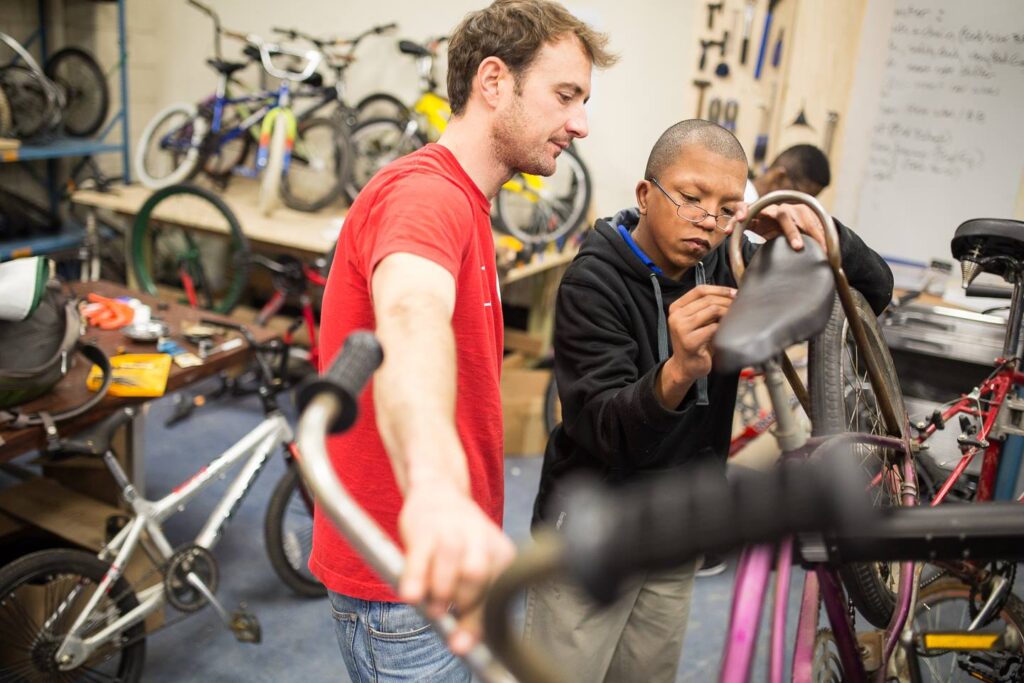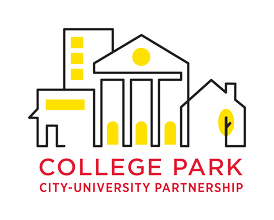Andy Dahl, Baltimore-based multimedia artist on the making of ‘The Last Goldfish’, College Park’s first mixed-media installation.
About the Artist
Andy Dahl is a painter, sculptor, filmmaker and public artist with an MFA from the Maryland Institute College of Arts (MICA). Though he currently resides in Baltimore, Andy grew up in a small town in the high desert in Southern California. In addition to producing large-scale public artworks, Andy has a background working as a community organizer focused on connecting resources to immigrant communities in Southeast Baltimore. Dahl is also an Innovation Fellow with the Warnock Foundation, and winner of the Saul Zaentz Innovation Fund in Film and Medial.
In this article, we sit down with Andy Dahl as he discusses the inspiration and making of ‘The Last Goldfish’, College Park’s first mixed-media installation.

Andy Dahl supporting youth in a bike shop.
“Transforming public space utilizing symbols representative of that community, its people, and its history is truly gratifying.“
Andy Dahl
Kendra McAbee: The story of Henry Bishop or ‘The Goldfish King’, sparked the inspiration for ‘The Last Goldfish’. The story of Henry Bishop is widely unknown, even to longtime residents of College Park. How did you find this story? What is your process when you come up with the concepts of your work?
Andy Dahl: I approach every project by diving into a general history of the area, and of course visiting it physically to get a more tangible feeling of the location. I look for what arouses a personal visceral reaction, and then just go with it. In this case, I read a couple of books on College Park: one on the history of the University of Maryland, and another on the Lakeland African American Community.
Given the location wasn’t exactly specific to either, I kept searching online to see what might pop out. Early on, I found articles about Henry Bishop, ‘The Goldfish King’. This quirky history of him raising goldfish in the now non-existent lakes in [East] Lakeland kept coming back to me. It had just the right amount of whimsy, meaning, and potential visual interest — I just went with it.
Goldfish are highly symbolic and, in some cases, representative of both preciosity and commonality. I guess I like that juxtaposition. Given I live in Baltimore, it didn’t hurt that Henry Bishop’s pet store was at one point located there.
KM: The installation uses a wood called Medium Density Overlay (MDO) that is normally used for industrial purposes. This wood isn’t a common media form for art – how did you come to use MDO in your work, and why did you use it in this installation?
AD: MDO is an industrial, marine-grade plywood I know of from its use by sign companies for its durability. It’s not a typical art material, I suppose, but I’m always in search of quality materials that I can utilize in creative ways. Its only real limitation is it’s generally made in either 4’X8’ or 4’X10’ pieces, and so if I want to make something bigger than that there will be a seam somewhere. It’s usually not very noticeable from a distance, however.
KM: While you do many different types of projects, you’ve been consistently producing public art since the early 2000’s. What keeps you coming back?
AD: I’d say I painted my first mural with a friend in a juvenile detention facility in Northern California back in 2002 or so. From there, I did a bunch of murals with youth in Paraguay and Bolivia, then stopped when I moved to New Orleans in 2009. I got back into it in Baltimore in 2012. Sometime thereafter, I stopped painting on canvas.
The collaborative nature and meaning-making that goes on when designing public artwork is really special. In this respect, I’m always beholden to a community somehow, and the process of making work on site is such a joy. For a brief time, I’m immersed in the energy of a community because I’m there working on the street for 8 or 10 hours a day, and sometimes at non-traditional work hours. I get to build relationships with passersby while they get to see the slow reveal of something transformative, and that’s the heart of why I do it. Transforming public space utilizing symbols representative of that community, its people, and its history is truly gratifying.
KM: The Last Goldfish, like many of your works in Baltimore, are highly visible in the cityscape. How do you feel when you pass by your work?
AD: It’s great to see them still existing in the world as a part of the fabric of their respective communities. In most cases they’ve also contributed to other improvements to the physical space around them whether that be new green space, safer pedestrian crossings, or established communal areas. Central to my design process is a consideration for the area surrounding the future artwork and how it fits and builds upon what’s already there, and so seeing improvements pop up after the installation is very rewarding to observe.
KM: Are there any projects you are looking forward to in 2025?
AD: I’m currently building a series of metal sculptures for a park in South Baltimore. I’m excited about it because It’s presenting a whole set of new challenges for me including being the largest metal artworks I’ve ever constructed. I can’t wait to share them with the world!
KM: What types of projects are you looking to do in the future?
AD: I’m really looking forward to working again in College Park and finding a creative solution to a complex public space. Hint. Hint…
Editor’s Note: This content has been slightly altered for the reader’s ease.
To explore more of Andy Dahl’s art, click here. You can also keep up with his latest projects on Facebook or Instagram. To learn more about ‘The Last Goldfish’, click here.
More Articles
